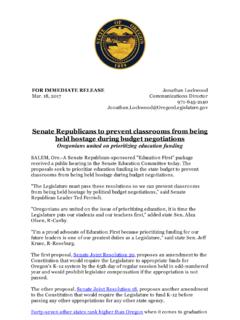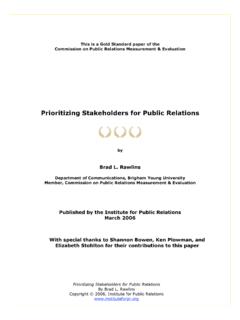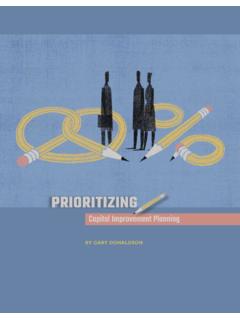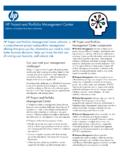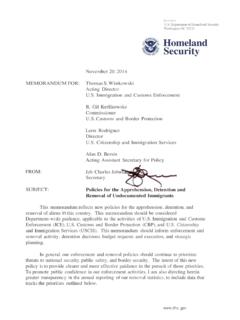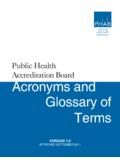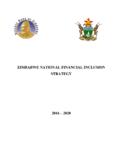Transcription of U.S. Department of Housing and Urban Development Office of ...
1 Department of Housing and Urban Development Office of Community Planning and Development Special Attention of: All Secretary's Representatives All Regional Directors for CPD All CPD Division Directors Continuums of Care (CoC) Recipients of the Continuum of Care (CoC) Program Notice: CPD-14-012 Issued: July 28, 2014 Expires: This Notice is effective until it is amended, superseded, or rescinded Cross Reference: 24 CFR Parts 578 and 42 11381, et seq. Subject: Notice on Prioritizing Persons Experiencing Chronic Homelessness and Other Vulnerable Homeless Persons in Permanent Supportive Housing and Recordkeeping Requirements for Documenting Chronic Homeless Status Table of Contents I. 2 A. Background .. 2 B. Goal of this Notice .. 2 C. Applicability .. 3 D. Key Terms .. 3 II. Dedication and Prioritization of Permanent Supportive Housing Strategies to Increase Number of PSH Beds Available for Chronically Homeless Persons .. 5 A. Increase the number of CoC Program-funded PSH beds that are dedicated to persons experiencing chronic homelessness.
2 5 B. Prioritize non-dedicated PSH beds for use by persons experiencing chronic homelessness.. 5 III. Order of Priority in CoC Program-funded Permanent Supportive Housing .. 6 A. Order of Priority in CoC Program-funded Permanent Supportive Housing Beds Dedicated to Persons Experiencing Chronic Homelessness and Permanent Supportive Housing Prioritized for Occupancy by Persons Experiencing Chronic Homelessness .. 6 B. Order of Priority in Permanent Supportive Housing Beds Not Dedicated or Prioritized for Persons Experiencing Chronic 8 IV. Using a Coordinated Assessment and a Standardized Assessment Tool or Process to Determine Eligibility and Establish a Prioritized Waiting 10 A. Coordinated Assessment Requirement .. 10 B. Written Standards for Creation of a Single Prioritized Waiting List for PSH .. 10 C. Standardized Assessment Tool Requirement .. 11 D. Nondiscrimination Requirements .. 11 V. Recordkeeping Requirements .. 11 A. CoC Records .. 11 B. Recipient Recordkeeping Requirements.
3 12 C. Recordkeeping Recommendations for CoCs that have Adopted the Order of Priority in this Notice.. 16 VI. Questions Regarding this 16 2 I. Purpose This Notice provides guidance to Continuums of Care (CoC) and recipients of Continuum of Care (CoC) Program (24 CFR part 578) funding for permanent supportive Housing (PSH) regarding the order in which eligible households should be served in all CoC Program-funded PSH. This Notice also establishes recordkeeping requirements for all recipients of CoC Program-funded PSH that includes beds that are required to serve persons experiencing chronic homelessness as defined in 24 CFR , in accordance with 24 CFR A. Background In June 2010, the Obama Administration released Opening Doors: Federal Strategic Plan to Prevent and End Homelessness (Opening Doors), in which HUD and its federal partners set goals to end Veteran and chronic homelessness by 2015, and end family and youth homelessness by 2020. Ending chronic homelessness is the first goal of Opening Doors and is a top priority for HUD.
4 Although progress has been made there is still a long way to go. In 2013, there were still 109,132 people identified as chronically homeless in the United States. In order to meet the first goal of Opening Doors ending chronic homelessness it is critical that CoCs ensure that limited resources awarded through the CoC Program Competition are being used in the most effective manner and that households that are most in need of assistance are being prioritized. Since 2005, HUD has encouraged CoCs to create new PSH dedicated for use by persons experiencing chronic homelessness (herein referred to as dedicated PSH). As a result, the number of dedicated PSH beds for persons experiencing chronic homelessness has increased from 24,760 in 2007 to 51,142 in 2013. This increase has contributed to a 25 percent decrease in the number of chronically homeless persons reported in the Point-in-Time Count between 2007 and 2013. Despite the overall increase in the number of dedicated PSH beds, this only represents 30 percent of all CoC Program-funded PSH beds.
5 To ensure that all PSH beds funded through the CoC Program are used as strategically and effectively as possible, PSH needs to be targeted to serve persons with the highest needs and greatest barriers towards obtaining and maintaining Housing on their own persons experiencing chronic homelessness. HUD s experience has shown that many communities and recipients of CoC Program-funded PSH continue to serve persons on a first-come, first-serve basis and/or based on tenant selection processes that screen-in those who are most likely to succeed. These approaches to tenant selection have not been effective in reducing chronic homelessness, despite the increase in the number of PSH beds nationally. B. Goal of this Notice The overarching goal of this Notice is to ensure that the homeless individuals and families with the most severe service needs within a community are prioritized in PSH, which will also increase progress towards the Obama Administration s goal of ending chronic homelessness.
6 In order to guide CoCs in ensuring that all CoC Program-funded PSH beds are used most effectively, this Notice establishes an order of priority which CoCs are strongly encouraged to adopt and incorporate into the CoC s written standards and 3 coordinated assessment system. With adoption by CoCs and incorporation into the CoC s written standards, all recipients of CoC Program-funded PSH must then follow this order of priority, consistent with their current grant agreement, which will result in this intervention being targeted to the persons who need it the most. Such adoption and incorporation will ensure that persons are housed appropriately and in the order provided in this Notice. HUD seeks to achieve three goals through this Notice: 1. Establish an order of priority for dedicated and prioritized PSH beds which CoCs are encouraged to adopt in order to ensure that those persons with the most severe service needs are given first priority. 2. Inform the selection process for PSH assistance not dedicated or prioritized for chronic homelessness to prioritize persons who do not yet meet the definition of chronic homelessness but are most at risk of becoming chronically homeless.
7 3. Provide uniform recordkeeping requirements for all recipients of CoC Program-funded PSH for documenting chronically homeless status of program participants when required to do so as well as provide guidance on recommended documentation standards that CoCs may require of its recipients of CoC Program-funded PSH if the priorities included in the Notice are adopted by the CoC. C. Applicability The guidance in this Notice is provided to all CoCs and all recipients and subrecipients the latter two groups referred to collectively as recipients of CoC Program-funded PSH. CoCs are encouraged to incorporate the order of priority described in this Notice into their written standards, in accordance with the CoC Program interim rule at 24 CFR (a)(9) and 24 CFR , for CoC Program-funded PSH. Upon incorporation of the order of priority into written standards CoCs may then require recipients of CoC Program-funded PSH to follow the order of priority in accordance with the CoC s revised written standards and this Notice and in a manner consistent with their current grant agreement.
8 D. Key Terms 1. Housing First. Housing First is an approach in which Housing is offered to people experiencing homelessness without preconditions (such as sobriety, mental health treatment, or a minimum income threshold) or service participation requirements and in which rapid placement and stabilization in permanent Housing are primary goals. PSH projects that use a Housing First approach promote the acceptance of applicants regardless of their sobriety or use of substances, completion of treatment, or participation in services. HUD encourages all recipients of CoC Program-funded PSH to follow a Housing First approach to the maximum extent practicable. Any recipient that indicated that they would follow a Housing First approach in the FY 2013 CoC Project Application must do so for both the FY 2013 and FY 2014 operating year(s), as the CoC score for the FY 2013 FY 2014 CoC Program Competition was affected by the extent in which project applications indicated that they would follow this approach and this requirement will be incorporated into the recipient s FY 2013 and FY 2014 grant agreement.
9 4 HUD recognizes that this approach may not be applicable for all program designs, particularly for those projects formerly awarded under the SHP or SPC programs which were permitted to target persons with specific disabilities ( , sober Housing ). 2. Chronically Homeless. The definition of chronically homeless currently in effect for the CoC Program is that which is defined in the CoC Program interim rule at 24 CFR , which states that a chronically homeless person is: (a) An individual who: i. Is homeless and lives in a place not meant for human habitation, a safe haven, or in an emergency shelter; and ii. Has been homeless and living or residing in a place not meant for human habitation, a safe haven, or in an emergency shelter continuously for at least one year or on at least four separate occasions in the last 3 years; and iii. Can be diagnosed with one or more of the following conditions: substance use disorder, serious mental illness, developmental disability (as defined in section 102 of the Developmental Disabilities Assistance Bill of Rights Act of 2000 (42 15002)), post-traumatic stress disorder, cognitive impairments resulting from brain injury, or chronic physical illness or disability; (b) An individual who has been residing in an institutional care facility, including a jail, substance abuse or mental health treatment facility, hospital, or other similar facility, for fewer than 90 days and met all of the criteria in paragraph (1) of this definition [as described in Section (a) of this Notice], before entering that facility.
10 Or (c) A family with an adult head of household (or if there is no adult in the family, a minor head of household) who meets all of the criteria in paragraph (1) of this definition [as described in Section (a) of this Notice, including a family whose composition has fluctuated while the head of household has been homeless. 3. Severity of Service Needs. This Notice refers to persons who have been identified as having the most severe service needs. (a) For the purposes of this Notice, this means an individual for whom at least one of the following is true: i. History of high utilization of crisis services, which include but are not limited to, emergency rooms, jails, and psychiatric facilities; or ii. Significant health or behavioral health challenges or functional impairments which require a significant level of support in order to maintain permanent Housing . 5 Severe service needs as defined in paragraphs i. and ii. above should be identified and verified through data-driven methods such as an administrative data match or through the use of a standardized assessment tool that can identify the severity of needs such as the Vulnerability Index (VI), the Service Prioritization Decision Assistance Tool (SPDAT), or the Frequent Users Service Enhancement (FUSE).]











